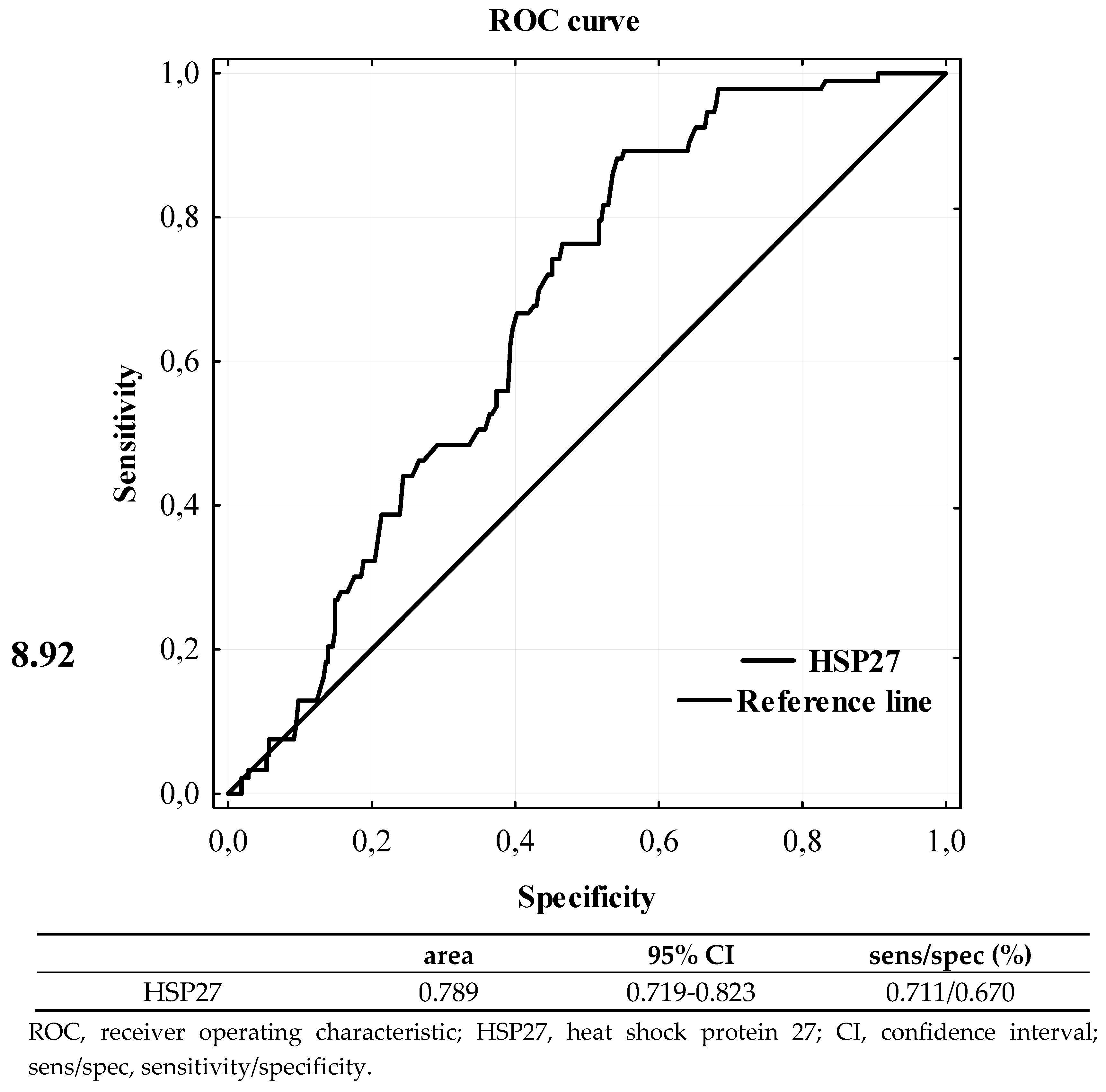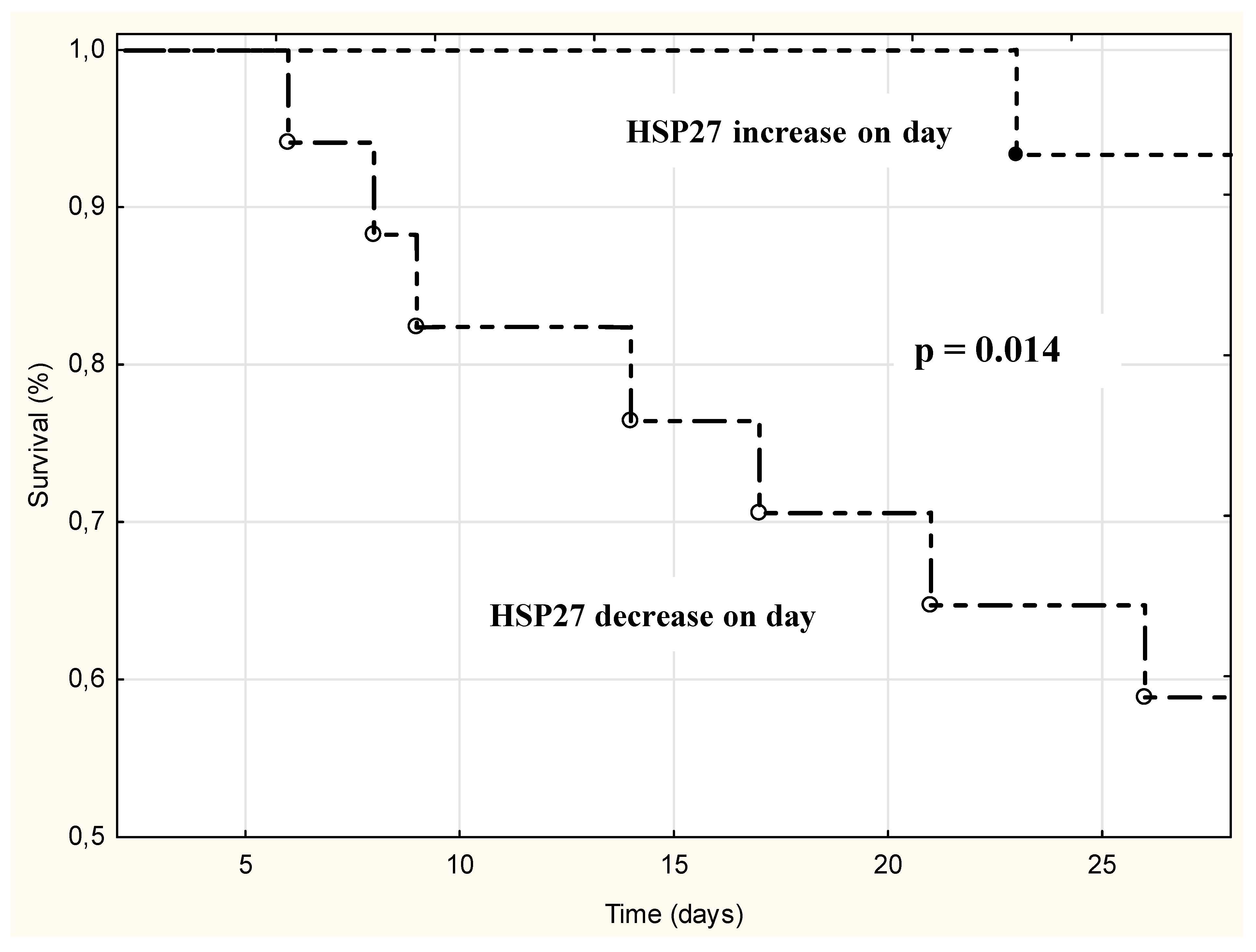Submitted:
29 May 2023
Posted:
31 May 2023
You are already at the latest version
Abstract
Keywords:
Introduction
Methods
Results
Discussion
References
- Singer, M.; Deutschman, C.; Seymour, C.; Shankar-Hari, M.; Annane, D.; Bauer, M.; Bellomo, R.; Bernard, G.; Chiche, J.; et al. The Third International Consensus Defnitions for Sepsis and Septic Shock (Sepsis-3). JAMA 2016; 315: 801–810. [CrossRef]
- Evans, L.; Rhodes, A.; Alhazzani, W.; Antonelli, M.; Coopersmith, C.; French, C.; Machado, F.; Mcintyre, L.; Ostermann, M.; et al. Surviving sepsis campaign: international guidelines for management of sepsis and septic shock 2021. Intensive Care Med 2021; 47: 1181–1247 . [CrossRef]
- Breed, E.; Hilliard, C.; Yoseph, B.; Mittal, R.; Liang, Z.; Chen, C.; Burd, E.; Brewster, L.; Hansen, L.; et al. The small heat shock protein HSPB1 protects mice from sepsis Sci Rep 2018; 8: 12493. [CrossRef]
- Jaroszyński, A.; Zaborowski, T.; Głuszek, S.; Zapolski, T.; Sadowski, M.; Załuska, W.; Cedro, A.; Małecka-Massalska, T. Dąbrowski, W.; Heat Shock Protein 27 Is an Emerging Predictor of Contrast-Induced Acute Kidney Injury on Patients Subjected to Percutaneous Coronary Interventions. Cells 2021, 10, 684. [CrossRef]
- Bolhassania, A.; Agi, E. Heat shock proteins in infection. Clinica Chimica Acta 2019; 498: 90-100. [CrossRef]
- Yu, A.; Li, P.; Tang, J.; Wang, J.; Chen, Y.; Liu, L. Roles of Hsp70s in Stress Responses of Microorganisms, Plants, and Animals. Biomed Res Int 2015; 2015:510319. [CrossRef]
- Zuo, D.; Subjeck, J.; Wang, X. Unfolding the Role of Large Heat Shock Proteins: New Insights and Terapeutic Implications. Front Immunol 2016; 7, 75 (2016).
- Vulczak, A.; Catalão, C.; de Freitas, L.; Rocha, M. HSP-Target of Therapeutic Agents in Sepsis Treatment. Int J Mol Sci 2019; 20: 4255. [CrossRef]
- Canul-Euan, A.; Zúñiga-González, G.; Palacios-Luna, J.; Maida-Claros, R.; Díaz, N.; Saltigeral-Tigeral, P.; García-May, P.; Diaz-Ruiz, O,; Flores-Herrera, H. Increased Levels of Plasma Extracellular Heat-Shock Proteins 60 and 70 kDa Characterized Early-Onset Neonatal Sepsis. Front Pediatr 2021. [CrossRef]
- Hashiguchi, N.; Ogura, H.; Tanaka, H.; Koh, T.; Nakamori, Y.; Noborio, M.; Shiozaki, T.; Nishino, M.; Kuwagata, Y.; Shimazu, T. et al. Enhanced expression of heat shock proteins in activated polymorphonuclear leukocytes in patients with sepsis. J Trauma. 2001;51(6):1104-1109. [CrossRef]
- Wischmeyer, E.; Kahana, M.; Ren, W.; Musch, M.; Chang, E. Glutamine induces heat shock protein and protects against endotoxin shock in the rat. J Appl Physiol 2001, 90, 2403–2410. [CrossRef]
- Singleton, K.; Serkova, N.; Beckey, V.; Wischmeyer, P. Glutamine attenuates lung injury and improves survival after sepsis: Role of enhanced heat shock protein expression. Crit. Care Med. 2005, 33, 1206–1213. [CrossRef]
- Zhao, Y.; Wang, H.; Liu, X.; Sun, M. Kazuhiro H. Protective effects of glutamine in a rat model of endotoxemia. Mol Med Rep 2012; 6: 739–744. [CrossRef]


| Varibles | Patients | Time points | ||||
|---|---|---|---|---|---|---|
| T0 | T1 | T2 | T3 | T4 | ||
| Procalcytonin (ng/mL) | Total | 7.43±3.92 | 5.94±3.61 | 4.91±2.68 * | 4.19±2.69 ** | 3.18±2.02 *** |
| Survivors | 7.19±3.61 | 5.21±3.26 * | 4.44±2.49 ** | 3.37±2.35 ** | 2.32±1.52 *** | |
| Non-survivors | 7.76±3.91 | 6.85±3.65 | 6.06±2.73 | 5.86±2.19 * | 5.89±2.15 * | |
| Presepsin (pg/mL) | Total | 1110.6 ±359.2 | 1120.5±430.3 | 942.3±330.5 | 856.7±350.7 * | 788.1±310.5** |
| Survivors | 1100.7±320.8 | 1108.4±460.1 | 890.9±270.0 * | 805.5±299.4 * | 730.4±286.5*** | |
| Non-survivors | 1150.3±326.8 | 1146.6±310.3 | 938.5±295.2 | 912.8±370.5 | 906.8±352.7 | |
| CRP (mg/ml) | Total | 302.3±61 | 274.3±56 | 253.6±59 * | 207.0±53 ** | 209.3±39 ** |
| Survivors | 301.2±60 | 264.5±58 | 219.6±57 ** | 201±53 ** | 200.7±50 ** | |
| Non-survivors | 304.8±59 | 286.1±52 | 249±56 * | 239.1±54 * | 231.2±55 * | |
| HSP27 (ng/ml) | Total | 5.96±1.75 | 5.70±1.73 | 5.65±1.70 | 7.26±1.76 * | 8.29±1.86 ** |
| Survivors | 5.92±1.94 | 5.78±1.89 | 5.63±1.89 | 7.98±1.79 * | 10.1±1.82 *** | |
| Non-survivors | 5.55±1.91 | 5.48±1.87 | 5.73±1.93 | 5.69±1.65 | 5.17±1.81 | |
| NLR (n) | Total | 19.9±8.22 | 20.1±8.31 | 19.3±7.12 | 17.23±6.03 | 14.62±7.12 * |
| Survivors | 19.9±7.97 | 19.0±8.02 | 17.86±8.13 | 16.24±7.56 | 12.33±7.53 * | |
| Non-survivors | 22.1±8.56 | 21.9±8.33 | 21.1±7.99 | 18.81±6.18 | 18.15±7.10 | |
| Characteristics | Univariate OR [95% CI] |
p-value | Multivariate OR [95% CI] |
p-value |
|---|---|---|---|---|
| Age, years | 1.021 [1.014–1.030] | 0.003 | 1.016 [1.010–1.029] | 0.009 |
| SOFA (n) | 1.309 [1.236–1.334] | <0.001 | 1.245 [1.211–1.249] | <0.001 |
| APACHE-II (n) | 1.175 [1.091–1.213] | 0.002 | 1.037 [1.011–1.043] | 0.009 |
| Initial lactate level, mmol/L | 1.156 [1.138–1.173] | <0.001 | 1.139 [1.111–1.166] | 0.001 |
| Procalcytonin (ng/mL) | 0.955 [0.853–1.208] | 0.009 | 0.961 [0.821–1.965] | 0.153 |
| Presepsin (pg/mL) | 0.975 [0.898–1.213] | 0.013 | 1.007 [0.715–1.643] | 0.206 |
| CRP (mg/ml) | 1.651 [1.211–2.931] | 0.205 | ||
| NLR (n) | 1.150 [1.072–1.434] | 0.198 | ||
| HSP27 (ng/ml) | 0.871 [0.805–1.009] | <0.001 | 0.902 [0.892–1.020] | 0.003 |
Disclaimer/Publisher’s Note: The statements, opinions and data contained in all publications are solely those of the individual author(s) and contributor(s) and not of MDPI and/or the editor(s). MDPI and/or the editor(s) disclaim responsibility for any injury to people or property resulting from any ideas, methods, instructions or products referred to in the content. |
© 2023 by the authors. Licensee MDPI, Basel, Switzerland. This article is an open access article distributed under the terms and conditions of the Creative Commons Attribution (CC BY) license (http://creativecommons.org/licenses/by/4.0/).





